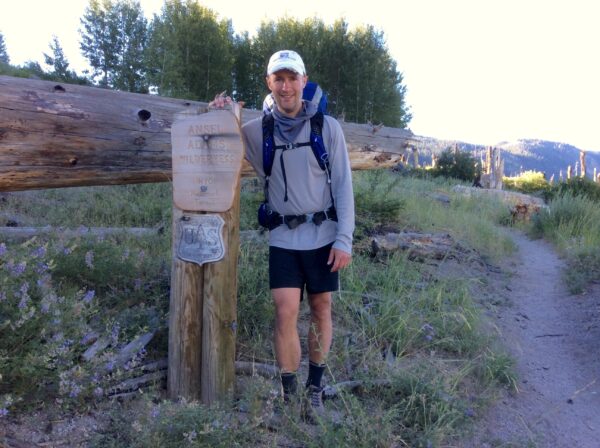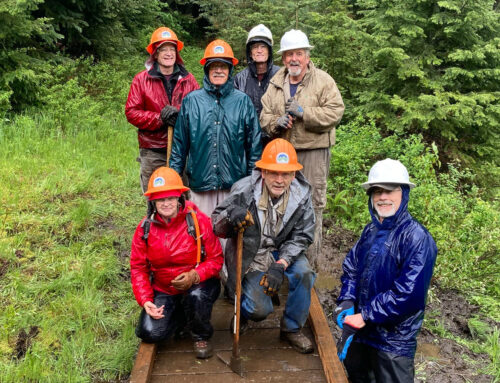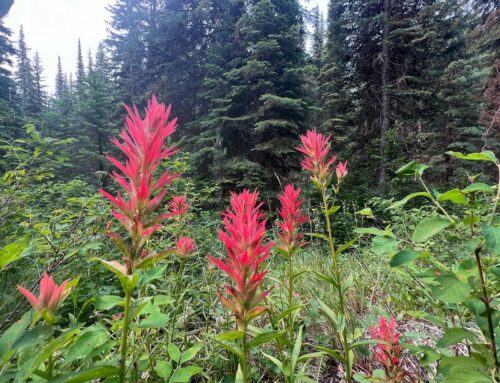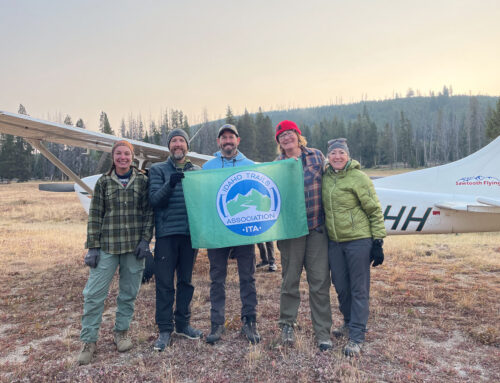
Brad helped to start ITA back in 2009 and recently volunteered many hours to create ITA’s new Frank Church-River of No Return Trail Map! He is heading up a new ITA volunteer opportunity of gathering GPS data in the south half of the Frank to produce a second map later this year. Thank you, Brad, for all you do for Idaho’s trails!
Tell us a little about yourself.
Twenty-five years ago I was hiking at Beehive Lake in the Selkirk Mountains. As I approached the lake, I could see a four-legged animal with hooves and antlers by the shore. It was not a deer, it was not an elk, and it was not a moose. I realized that the only other ungulate that it could be was a mountain caribou. That experience shaped my appreciation for both the environment and hiking. I went on to get a degree in environmental science from the University of Idaho and an advanced degree in public policy and administration from Boise State. A career in environmental advocacy with the Idaho Conservation League followed. Fly-fishing, skiing and hiking are my three favorite outdoor activities. They help get me out into nature and clear my head. I’m not against motorized recreation or mountain biking, but I am a minimalist, and I love the freedom that hiking affords in terms of where you can go. I also enjoy history, beer, and live music.
How and why did you first get involved with ITA? What are the different ways you’ve volunteered for ITA over the years?
I was approached by Sally Ferguson sometime in 2009 about the idea of starting up an organization in Idaho, dedicated to hiking. Sally and I were both aware of the Washington Trails Association and all of the wonderful work that WTA does to maintain trails and advocate for the interest of hikers in our neighboring state. A similar voice was clearly missing in Idaho.
In 2010 we recruited Brad Brooks, Zac Crist, and Rob Mason to help start ITA. We applied for grants from REI and the National Forest Foundation to do two trail projects that year. When the summer was over, we wrote the first strategic plan. I drafted articles of incorporation and filled them with the IRS. After ITA was fledged, I stepped down from the board to watch ITA take flight and be a father.
Now that my daughter is a teenager, I have more time to devote to ITA again. One day I was looking at some Forest Service maps of the Frank Church-River of No Return Wilderness. The most recent maps of the area were published by the Forest Service in 1984. I have a love of cartography and learned how to use GIS software for this purpose. I approached ITA about creating new, up-to-date trail maps for the Frank. The north half map was just published, and I hope to finish a map for the south half of the Frank by the end of the year.
While working on the map for the north half of the Frank, I learned that not all of the Forest Service’s trail data is current. Somehow we needed to get our hands on accurate information about the location and condition of trails in the Frank. I suggested to ITA that we try and recruit some volunteers to go hike out in the Frank with some GPS units so that we can produce accurate maps and identify locations where trail maintenance is needed. I volunteered to help pilot and manage the new Trail Scouting Program this year. We’re hoping to scout about 370 miles in the southwest corner of the Frank this year, but we’re going to need volunteers to do it.
What do you like about volunteering with ITA?
I love volunteering for ITA because of my passion for hiking. It’s a way to keep the opportunity of hiking alive in a place where there aren’t a whole lot of resources for trail maintenance.
I also love volunteering for ITA because the results of my labor are clearly evident at the end of the day, especially when it comes to swinging a Pulaski or grading a trail with a McLeod. We put a lot of work into things in life where the results aren’t immediately tangible–if ever. That’s not the case with trail work.
Most memorable backcountry or ITA experience?
I wasn’t on the volunteer crew that discovered it, but I was shocked when some ITA members located a barbeque, a dining table, and some chairs out in the middle of the Sawtooth Wilderness. After it was reported to the Forest Service, I believe it was determined that someone with some money had those things flown into the Sawtooths with a helicopter for a private dinner or reception. It just made me wonder who in the world thinks they are so special that they can spend all that money, break the law, and then just leave it all there? It was comical and mind-boggling at the same time.
Why are trails worth protecting?
Trails provide an opportunity to connect and commune with nature. There are a lot of mental stressors on people and society. For whatever reason, perhaps because of our beginnings as a species, most humans seem to feel revived after spending time outdoors. That’s certainly true for me. Trails are worth protecting because it makes it possible to connect with nature, especially in the backcountry where you can really remove yourself from civilization.
What is your hope for the future of Idaho’s environment/public lands/trails?
I’ve been truly blessed with the opportunity to enjoy Idaho’s backcountry, drink clean water, and breathe clean air. There are a lot of threats facing our environment and our planet, and I worry that my daughter and my grandkids will not have the same opportunities that I did or be able to live in a healthy environment. I hope that humans can muster the will to do something about climate change, pollution, and the other threats facing Idaho and our world.




Leave A Comment